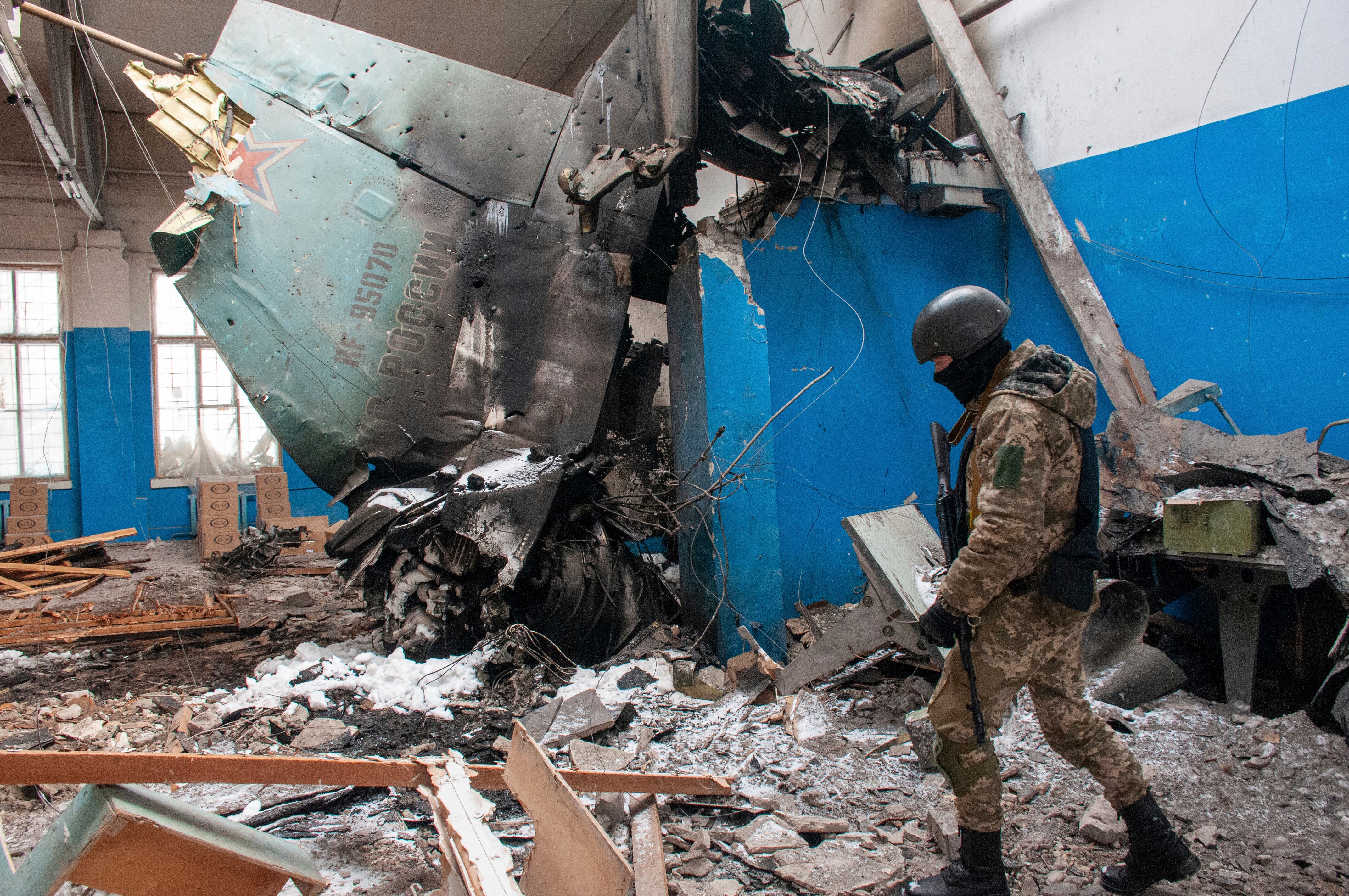Congressional leaders on Wednesday unveiled a compromise budget bill which includes Defense Department funding for the rest of fiscal 2022 and $13.6 billion extra in emergency assistance for Ukraine and NATO allies.
Now they have to pass it.
House and Senate appropriators worked late into the night on the $1.5 trillion measure, which includes $728.5 billion in military spending for the year. That’s a 5.6 percent boost over fiscal 2021 funding levels, and above what President Joe Biden had requested in his federal spending plan.
But Democratic leaders said the budget also includes an even larger boost (6.7 percent) for non-defense spending and represents a needed balancing of spending priorities for the government.
RELATED

In a statement, House Appropriations Committee Chairwoman Rosa DeLauro, D-Conn., said the compromise plan “responsibly addresses our national security with funding for a robust mix of diplomacy, defense, and global development.”
If lawmakers can finalize the deal in the next few days, they’ll both stave off a partial government shutdown (current agency funding is set to run out on March 11) and provide budget stability for the rest of fiscal 2022, which runs through Sept. 30.
In recent months, Defense Department leaders have been forced to move money between various accounts to offset funding shortfalls caused by short-term budget extensions passed by Congress. The current fiscal year began on Oct. 1, meaning federal agencies have been operating without a permanent budget deal for nearly six months.
The latest budget breakthrough will require lawmakers to pass one more short-term budget extension — through March 15 — to give lawmakers time to finalize the larger, year-long deal. Chamber leaders said they’ll work on that over the next few days.
Ukraine aid
In addition to the base budget, lawmakers added $13.6 billion to the budget package to provide additional aid and assistance to Ukraine and NATO countries alarmed by Russia’s aggression in eastern Europe over the last few weeks.
Ukrainian leaders have pressed for additional military and humanitarian aid to combat the full-scale Russian invasion of their country which began on Feb. 24. Since then, thousands of Russian troops, Ukrainian military members and Ukrainian civilians have been killed in the fighting.
Congress plans to divide the emergency funding among several agencies. About $6.5 billion will go to the Department of Defense, with more than half of that total set aside to restore military stocks of equipment already transferred to Ukraine.
RELATED

About $3.1 billion will cover “deployment, operational, and intelligence costs” for U.S. forces deployed to Europe in response to the Russian actions. Nearly 15,000 American service members have been deployed to the region in support of NATO allies in recent weeks, but none have been sent into Ukraine itself.
The bill also funds the Ukraine Security Assistance Initiative — used to help train and equip the Ukrainian military — at $300 million.
The State Department will receive about $4 billion for “the rapidly expanding humanitarian crisis in Ukraine.” Officials say more than 12 million people in the region are in need of food, shelter, and other basic necessities because of shortages caused by the fighting.
Another $650 million would be provided for military support and “an expansion of existing authorities to bolster the defense capabilities of the Ukrainian military and regional allies.”
Other money would be set aside to enforce sanctions against Russia for the military assault and for economic assistance for Ukraine and other European allies.
Senate Appropriations Committee Chairman Patrick Leahy, D-Vt., said the plan “provides critical assistance to Ukraine and our NATO allies at a time when they need it the most.” DeLauro echoed that sentiment, saying American lawmakers must react to “Russia’s unprovoked war of aggression” against its neighbor.
Defense funding
The military spending totals in the budget compromise bill include funding for the 2.7 percent military pay raise that went into effect on January 1 and enough personnel support for an end strength of 1.34 million troops, slightly below the fiscal 2021 total.
Lawmakers also included $278 million in housing assistance for military families facing rental cost increases and other housing issues caused by ongoing coronavirus pandemic, and $686 million to deal with the continuing water contamination issue linked to the Red Hill Bulk Fuel Storage Facility in Hawaii.
About $1.4 billion would be set aside for “Countering China and investing in the Indo-Pacific,” to include new missile tracking efforts in the region and establishing new defense monitoring stations in Hawaii and Guam.
For the Navy, lawmakers agreed to $26.7 billion for 13 Naval vessels, including two VIrginia-Class submarines, two DDG- 51 Arleigh Burke Class destroyers, one Constellation-Class frigate, one expeditionary sea base, two fast transports (including one medical variant), two oilers, two tugs, and one surveillance ship.
Navy and Marine aircraft procurement accounts rose more than $1 billon above Biden’s request, for 12 more F/A-18E/F Hornets, two more CH-53K King Stallions, four added MV-22 Ospreys and two more MQ-4 Tritons.
The Navy’s Shipyard Infrastructure Optimization Plan won more than $500 million above Biden’s request, largely split between industrial equipment and facility renovations.
For the Air Force, appropriators highlighted $1.8 billion to buy 16 C-130J aircraft to modernize two Air National Guard operational wings. They added eight UH-N1 replacement aircraft and four MQ-9s among other moves.
For the Army, appropriators added about $500 million for Army aircraft, chiefly to add more UH-60 Blackhawks, CH-47 Chinooks and Grey Eagle drones. They also added more than $300 million for Stryker and Abrams upgrades.
The bill’s security assistance funding included a sought-after $1 billion for Israel to replenish the Iron Dome missile defense system, used earlier this year to counter rockets fired at the Jewish State from Gaza.
RELATED

In addition to the Ukraine aid, the new defense budget plan also contains more money for other security cooperation programs, including $165 million for coordination with African nations, $500 million to support Iraqi security forces, and $300 million for work with Eastern European partners “facing Russian aggression.”
Veterans Affairs funding
Under the compromise budget, the Department of Veterans Affairs would see nearly $270 billion in available spending this fiscal year, the largest budget in agency history.
In fiscal 2001, the VA budget totaled about $45 billion. By fiscal 2011, it was about $125 billion, almost triple that total. Ten years later, in 2021, the department’s budget was nearly double that again, at $245 billion.
The new funding plan would invest more money in mental health care initiatives ($13.2 billion, up 28 percent from fiscal 2021), efforts to prevent veterans homelessness ($2.2 billion, up 12 percent) and women’s health care programs ($840 million, up 14 percent).
The plan also calls for $1.4 billion in spending for VA’s caregiver support programs, up about 14 percent from last year. The program is scheduled to undergo a major expansion this fall, potentially adding tens of thousands more veterans.
Lawmakers also allotted more money for major and minor construction projects (up 23 percent and 40 percent, respectively), but the roughly $2.1 billion in total spending for those accounts still falls short of what advocates say is needed to update the department’s aging infrastructure.
Both chambers were expected to begin debate on the budget plans on Wednesday. The White House has already signaled support for getting the compromise finalized as soon as possible.
“The bipartisan funding bill is proof that both parties can come together to deliver for the American people and advance critical national priorities,” Shalanda Young, acting director of the Office of Management and Budget, said in a statement.
“It will mean historic levels of assistance for the Ukrainian people … I urge Congress to send this critical legislation to the president’s desk for signature without delay.”
Leo covers Congress, Veterans Affairs and the White House for Military Times. He has covered Washington, D.C. since 2004, focusing on military personnel and veterans policies. His work has earned numerous honors, including a 2009 Polk award, a 2010 National Headliner Award, the IAVA Leadership in Journalism award and the VFW News Media award.
Joe Gould was the senior Pentagon reporter for Defense News, covering the intersection of national security policy, politics and the defense industry. He had previously served as Congress reporter.









